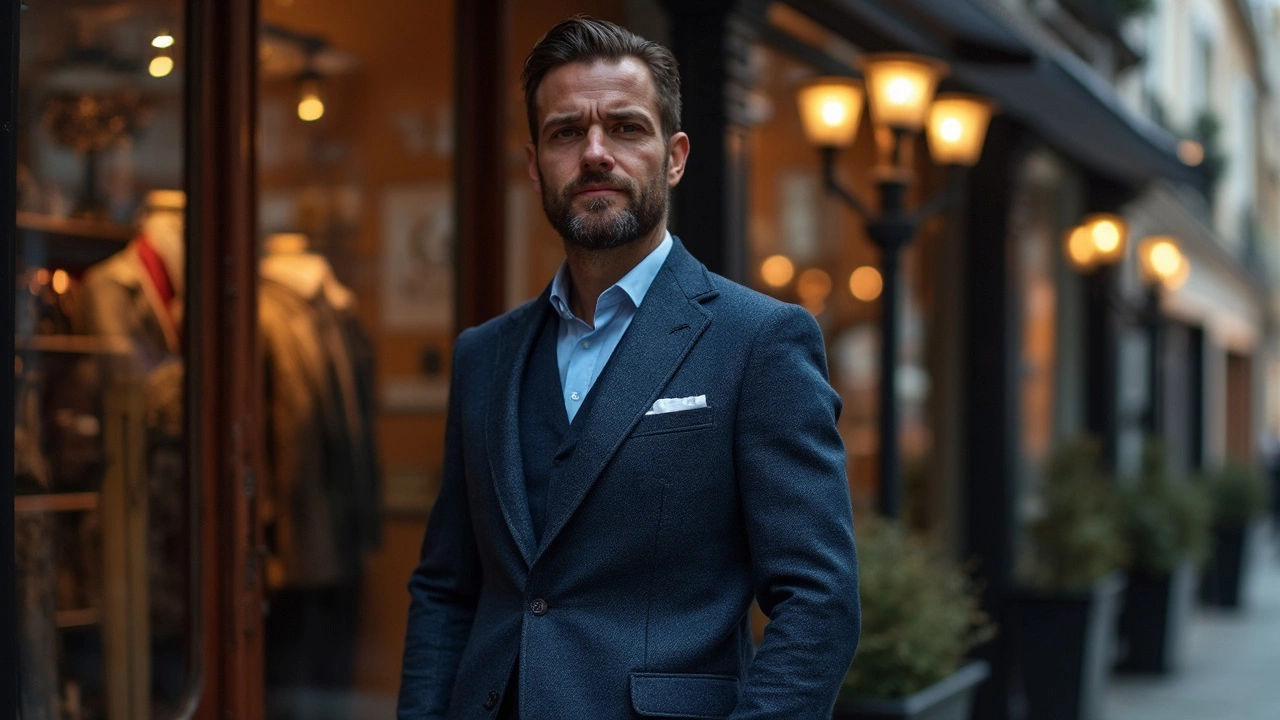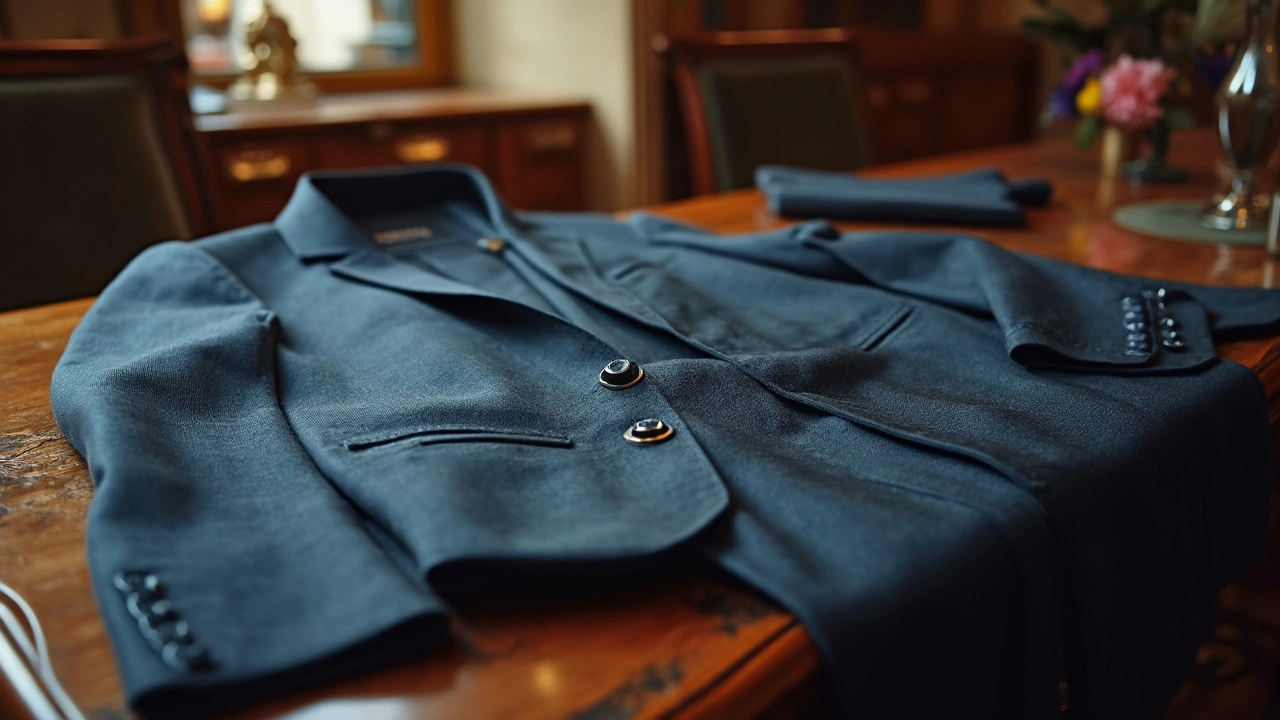Spotting an Expensive Suit: Here's How to Tell

- Cleo Fairchild
- 7 April 2025
- 0 Comments
So, you're on a mission to figure out if a suit is really worth the big bucks, huh? Well, you're in the right place. Let's kick things off by talking about fabric. A top-notch suit usually screams quality because of its material. Touch it. Feel the texture. Is it smooth and soft? Luxurious wool, cashmere, or a silk blend are your go-tos for a high-end suit. They tend to drape better and feel great against the skin.
Next up, let's chat about the fit. A well-fitted suit is like a perfectly tailored glove. It feels like it was made just for the person wearing it. Check the shoulders—if they sit right without any puckering or divots, you're on the right track. A lousy fit is a dead giveaway that a suit might not be worth as much as it boasts.
- Fabric Quality: The Foundation of Luxury
- Perfect Fit: A Sign of Expert Tailoring
- Stitching: Where the Details Shine
- Brand Reputation: The Mark of a True Designer
- Little Extra Touches: Buttons and Linings
- How to Spot the Real Deal: Practical Tips
Fabric Quality: The Foundation of Luxury
When it comes to expensive suits, the fabric is where it all begins. It's the most vital element that sets a luxury suit apart from the rest. High-quality materials like wool, cashmere, and silk blends don't just look premium—they offer a comfort that cheaper fabrics can't replicate.
Let’s get specific. Wool is the mainstay of most men's suits. High-end suits often use Super 100s to Super 250s wool, which indicates the fineness—higher numbers mean finer threads. Think of it like the thread count in bed sheets. The higher, the more luxurious.
If you've ever touched a suit that felt buttery smooth, there's a chance it's made of cashmere. Cashmere is incredibly soft but can also be quite delicate. It's often blended with wool to strike the perfect balance between softness and durability.
For something a bit flashier, some luxury suits incorporate silk. This gives the suit a slight sheen and an elegant drape. But be careful—silk suits can be a tricky beast, prone to wrinkling and more appropriate for special occasions rather than everyday wear.
A great way to judge fabric quality is by the weight as well. Good quality fabric feels substantial, not flimsy. And here's a neat little trick: scrunch up a bit of the fabric in your hand, release it, and see how quickly it returns to its natural state. A quality fabric won’t crease easily.
Here's the kicker: choosing the right fabric can impact not only your comfort but also the suit’s durability. Cheap fabrics may fade or wear out quickly, while luxury fabrics maintain their appearance for years. Investing in quality fabric means your suit can last longer, making it a clever purchase in the long run.
Perfect Fit: A Sign of Expert Tailoring
You know how some folks look like they were born to wear a suit? That's not magic—it's expert tailoring that ensures the perfect fit. High-quality suits are cut to match every unique curve and line of the buyer's body. Check the shoulder area first; it should lie flat and seamlessly meet the sleeve, without any wrinkles or gaps. This is usually the first tell-tale sign of skilled craftsmanship.
Now, glance at the waist. Is the jacket snug but not suffocating? Is there a smooth line from the underarm to the lapel? Tailors call this the 'dart line,' and in an expensive suit, it'll hold its form beautifully without looking boxy.
Accurate sleeve length is another giveaway. Expensive suits have sleeves that end just where they should, allowing a half-inch of shirt cuff to peek out—a classic touch of elegance. Trousers should break just at the shoelaces for that polished, never-sloppy look.
A seasoned tailor once said, "A well-tailored suit is to women what lingerie is to men." It's about precision and making things fit exactly right.
Not every off-the-rack suit will offer this out of the box, but if a suit's been hand-fitted or bespoke, you'll notice every detail is just right. Keep an eye out for this, and you're halfway to spotting luxury.
Tailoring perfection doesn’t just bring visual appeal—it actually accentuates comfort. When everything is in its place, wearing that suit becomes a personal experience rather than just formal wear.
Stitching: Where the Details Shine
You might not always see it at first glance, but stitching is a dead giveaway of an expensive suit. Carefully crafted suits will have immaculate stitching that stands up to close scrutiny. Let's break it down, shall we?
Start with the seams. They're not just holding the suit together; they're also part of what makes it look sharp. Well-made suits usually have fine and dense stitching, meaning the stitches are small and close together. This not only gives a neat appearance but also adds durability to the garment.
Then there's the lining. In a quality suit, the lining is often attached by hand, especially around tricky areas like the shoulder and lapel. Check this by flipping the lapel and looking for tiny, almost invisible stitches. This handwork is something you just don't find in cheaper mass-produced suits.
If you're peeking inside, notice details like pick stitching, which is a tiny decorative stitch near the edges of the lapels and pockets. It's a subtle touch that most people overlook, but real experts know it when they see it. It's not just for show; it's an extra layer of stitching that can reinforce the garment.
A true test of a luxury suit is whether buttons are sewn with a shank, which allows them to move smoothly through buttonholes without pulling on the fabric. If you're eyeing a men's suit that's pulling a bit at the buttons, it might not have the fine stitching work you'd expect from a high-end piece.
Stitching might seem minor, but these tiny details are where an expensive suit shows its worth. Next time you're inspecting suits, take a closer look at those seams. You might just be holding a treasure trove of quality work in your hands!

Brand Reputation: The Mark of a True Designer
When it comes to spotting an expensive suit, brand reputation is often a major clue. Why? Because certain names are synonymous with impeccable style and top-tier craftsmanship. We're talking about the big players like Armani, Tom Ford, and Hugo Boss. These brands have spent decades building their reputations for a reason. It's all about their commitment to quality and the classic, yet innovative designs they roll out season after season.
For instance, Armani suits are known for their clean lines and sophisticated look. They're the go-to for anything from boardrooms to red carpet events. Meanwhile, Tom Ford is all about bold, sharp silhouettes that really stand out. Hugo Boss brings a mix of modern and classic, perfect for those who want a bit of both worlds.
But it's not just the big names—many other lesser-known designers are gaining traction for their quality, too. Brands like Canali and Brioni might not be the first names everyone mentions, but their suits are nothing short of luxury. These brands offer hand-finished details and exclusive fabrics, which definitely put a few extra pounds on the price tag.
So, looking for a designer label can be a solid initial indicator of whether a suit is really high-end. Sure, there are exceptions, but in most cases, well-known brands bring together great materials and skilled tailoring. Plus, their long-standing popularity and recognition are often built on consistent quality.
That said, being brand-savvy doesn't just mean recognizing famous logos. It's also about understanding why some brands hold that prestigious spot. This is where a bit of research and familiarity with the industry definitely helps. Check how long the brand has been around, their signature cuts, and customer reviews. That'll give you a clearer picture of its standing in the fashion world.
Little Extra Touches: Buttons and Linings
Alright, let's get into the juicy details—the bits that really set an expensive suit apart: those little extras like buttons and linings. Ever heard someone say, 'the devil's in the details'? Well, when it comes to suits, it's absolutely true.
First up, let's talk buttons. If they're made from natural materials like horn, bone, or mother-of-pearl, you're likely dealing with a high-quality piece. Metal buttons, though less common, also hint at quality if they're used thoughtfully. Plastic? Eh, that's usually a red flag for something not quite as luxurious. Check if they're overlapping; that's an extra touch of craftsmanship that many high-end suits have.
Now onto linings. In an expensive suit, the lining is like a secret world of opulence just for the wearer. Quality suits often sport linings of silk or Bemberg—both materials that feel breathable and smooth. Plus, the patterns can be a little wild, allowing for a pop of personality. Slipping on a lined jacket feels different—like stepping into something made just for you.
And here's a nugget that's too good not to share. If you ever spot contrasting color stitching around the buttonholes, take a closer look. It's a sign of bespoke tailoring—a hallmark of luxury suits. These details might not seem like much, but they add up, making the suit feel one of a kind.
In the end, these small touches can make or break the impression of a suit. Next time you're checking out a suit, let your fingers do the exploring—feel those buttons, peek at that lining, and you'll be a step closer to knowing if it's the real deal.
How to Spot the Real Deal: Practical Tips
When you're trying to figure out if a suit's the real expensive deal or just a poser, there's a bunch of things you can check out to make it easier. First thing you wanna do is inspect the tags. Does the label mention natural materials like wool, cashmere, or silk blends? These are often found in a really expensive suit, unlike cheaper synthetic fabrics.
Another pro tip is to examine the stitches. Hand stitching is a hallmark of quality. Look closely—are the stitches consistent and barely noticeable? That's a good sign. Those little flaws or character traits in hand stitching can often mean it's not machine-made. A close look at the lapels can also give you clues. A nicely rolled lapel is usually attached by hand and shows craftsmanship.
Don't overlook the lining, either. Quality suits usually sport a lining made from viscose or silk, unlike cheaper polyester. Plus, a bit of flair in lining patterns often means the designer added something extra, hinting at a higher price tag.
- Feel the Weight: Quality suits carry a bit of weight because of the fine materials used. Light and flimsy? That's probably not the one.
- Button Up: Check the buttons. High-end suits often use mother-of-pearl or horn buttons, not plastic. Touch them, if they feel slick and cool, you might have a winner.
- Reputation Matters: Before the purchase, do a quick search on the brand. A reputable brand is less likely to disappoint in terms of quality and durability.
If you're a numbers person, look at this quick table showing the difference in material durability:
| Material | Durability (Years) |
|---|---|
| Wool | 10+ |
| Polyester | 3-5 |
| Cashmere | 10+ |
In the end, pairing these tips with your instincts will usually point you in the right direction. Arm yourself with this info, and you’ll be a pro at spotting a truly luxury suit from one that's all hype.


